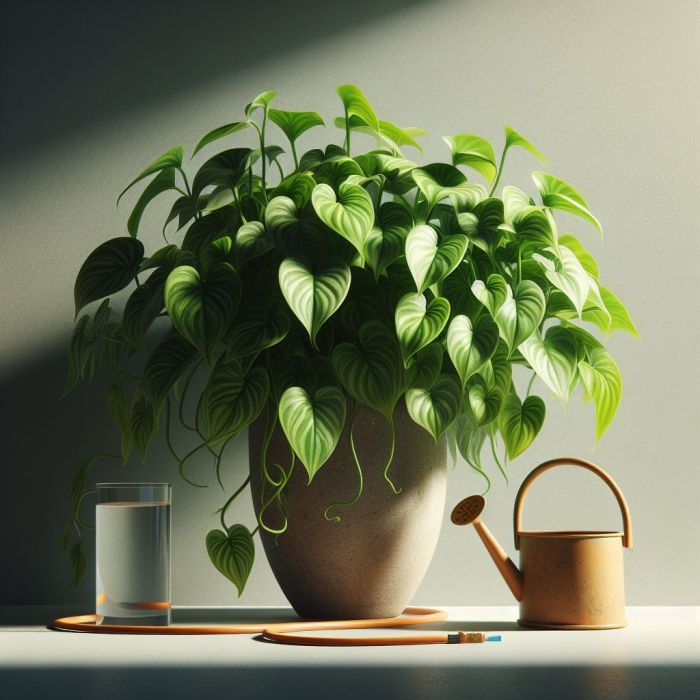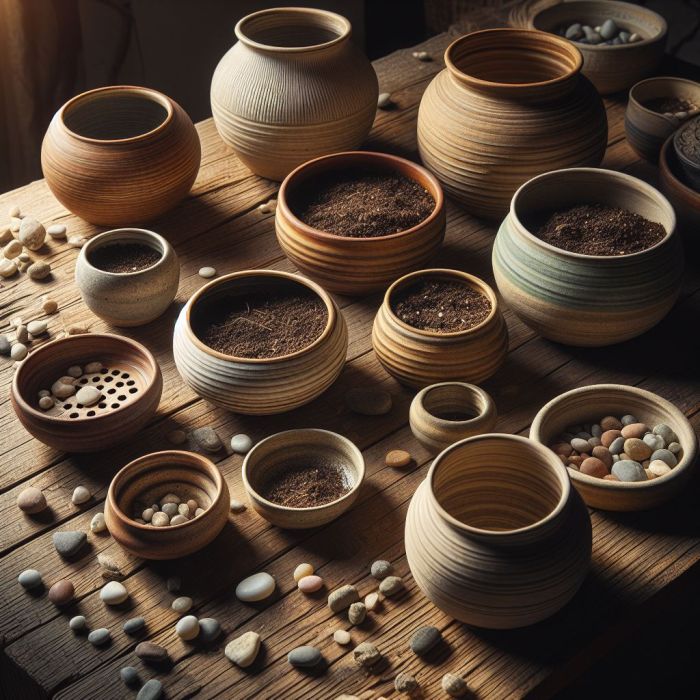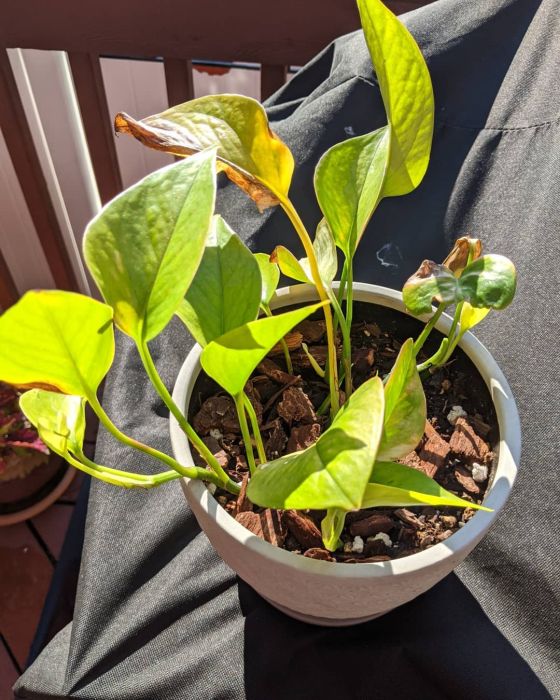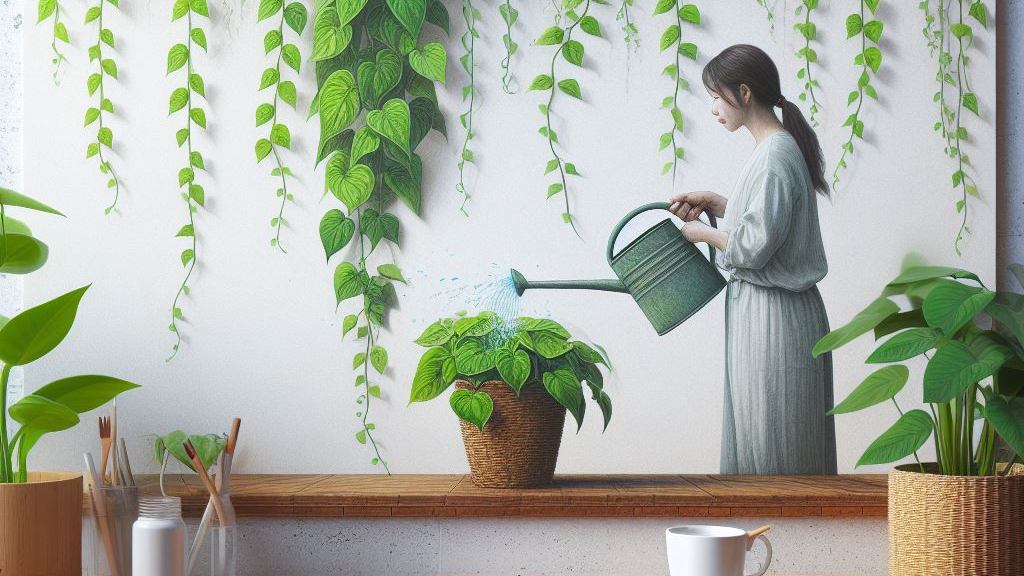Last updated on March 3rd, 2024 at 02:39 am
Establishing a proper pothos watering routine is crucial for the well-being of your plant, scientifically termed Epipremnum aureum, it has gained widespread popularity as a versatile and easy-to-care-for houseplant, prized for its air-purifying properties. Establishing a proper watering routine is crucial for the well-being of your Pothos.
Despite their reputation as resilient plants, Pothos can suffer if overwatered or underwatered. Many novice gardeners mistakenly assume that Pothos, being tropical, requires frequent watering, leading to potential harm. Understanding the correct watering frequency is paramount to ensuring the health of your plant and avoiding issues like root rot.
Pothos are cherished by beginner plant enthusiasts due to their lush green foliage and easy maintenance, but they require proper care to grow well, with establishing a consistent pothos watering routine is a critical aspect. Let’s delve into the ideal watering frequency for Pothos and the various factors that can influence their watering needs.
Originating from the Solomon Islands in the South Pacific, Pothos is a tropical vine commonly found cascading from shelves and desks in indoor settings. With their heart-shaped green leaves, sometimes adorned with variegated patterns, Pothos adds a touch of greenery to any space. These plants are resilient and adaptable to various light, soil, and moisture conditions, thriving even indoors with minimal care. However, it’s essential to note that Pothos are toxic to pets, so caution is necessary when placing them in pet-inhabited spaces.
Contents
- 1 Understanding Pothos Watering Routine And Needs:
- 2 Identifying Signs of Overwatering in Your Pothos Plant
- 3 Tips for Successful Pothos Watering Routine:
- 4 FAQs about Pothos Watering Routine:
- 4.1 Why is establishing a proper pothos watering routine important?
- 4.2 Can I use tap water for watering my Pothos?
- 4.3 How can I prevent overwatering my Pothos plant?
- 4.4 What are the signs of overwatering in a Pothos plant?
- 4.5 How often should I water my pothos plant?
- 4.6 How can I maintain a healthy pothos watering routine?
- 5 Author
Understanding Pothos Watering Routine And Needs:

Pothos plants come from tropical areas where they grow under trees, getting sunlight that’s filtered through leaves. To keep them happy, it’s important to establish a proper pothos watering routine.
Here are seven essential guidelines to follow when watering your Pothos plant:
Before delving into the specifics of watering your Pothos plant, let’s examine the six universal rules that apply to all Pothos plants in any indoor environment.
Familiarize yourself with these rules, commit them to memory, and implement them consistently, and soon you’ll become adept at maintaining a proper pothos watering routine.
Ensuring Good Drainage:

To ensure your pothos thrives, providing proper drainage in its pot is crucial. Ensure that your pothos pot has drainage holes at the bottom. Additionally, use a well-draining soil mix specifically formulated for indoor plants. Without adequate drainage, water can accumulate at the bottom of the pot, leading to root rot and other issues that can harm your pothos.
Checking Soil Moisture:
Before reaching for the watering can take a moment to check the soil moisture. Stick your finger about an inch into the soil. If it feels dry to the touch, it’s time to water your pothos. For larger pots, such as those over eight inches wide, you may need to check the soil’s moisture deeper down, aiming for about one-third of the pot’s height to be dry before watering again.
Avoiding a Set Schedule:
While it may be tempting to water your pothos on a fixed schedule, it’s best to avoid this approach and instead establish a flexible pothos watering routine. The watering needs of your pothos can vary depending on factors such as the season, humidity levels, and environmental conditions. Instead of sticking to a rigid schedule, monitor the soil moisture regularly and water your pothos when the soil is dry. This helps prevent both overwatering and underwatering, ensuring optimal health for your plant.
Giving Enough Water:
When it’s time to water your pothos, be sure to give it a thorough watering. Water the plant until you see water coming out of the drainage holes at the bottom of the pot. This ensures that the entire root system receives moisture and encourages healthy root growth. However, it’s important to water only a few times a week, as this can lead to waterlogged soil and root rot. Using a well-draining soil mix helps prevent overwatering by allowing excess water to drain away effectively.
Using Water at Room Temperature:
To avoid shocking your pothos’ roots, use room-temperature water for watering. Allowing the water to sit out overnight before using it helps it reach room temperature and ensures a gentle watering experience for your plant.
Consistent Watering:
While it’s essential to avoid overwatering your pothos, it’s equally important to maintain a consistent pothos watering routine. Aim to water your pothos when the soil is dry, but don’t let it stay dry for too long. Consistent watering helps keep your pothos healthy and prevents stress on the plant.
Proper Watering Techniques:
When watering your pothos, as part of your pothos watering routine, direct the water to the base of the plant, avoiding wetting the foliage excessively. Watering at the base helps prevent issues such as fungal diseases and keeps the leaves clean, promoting better photosynthesis. Additionally, allow any excess water to drain freely from the pot to avoid waterlogging the soil. By following proper watering techniques, you can ensure the health and vitality of your pothos plant.
Identifying Signs of Overwatering in Your Pothos Plant

Image credit: #pothoslove1
Recognizing when your Pothos plant is receiving too much water is essential for its health. Here are the common indicators of overwatering to be aware of:
Signs of Overwatering:
Leaf Discoloration:
- Yellowing leaves
- Soft, brown spots on leaves
- Black spots on leaves
Stem Issues:
- Blackened stems
Root Problems:
- Brown spots on leaves with a yellow outline (indicative of root rot)
Other Visual Clues:
- Water blisters or leaf edema
- Wilting or drooping leaves
- Leaf shedding
Soil and Environmental Cues:
- Mold growth on the soil surface
- Presence of fungus gnats flying around the plant
It’s crucial to note that these symptoms may take time to appear, indicating a significant issue with your plant’s well-being once noticeable. For instance, blackened leaves and stems suggest prolonged exposure to waterlogged soil, necessitating immediate intervention to save the plant.
Additionally, these signs may not exclusively point to overwatering, as they could also indicate other underlying issues such as pests or nutrient deficiencies. For example, yellowing leaves could signal both dehydration and overwatering.
When uncertain, always investigate the root cause of the problem by examining the soil in the pot and evaluating the overall plant condition. Taking swift action can help address any damage and restore your pothos to optimal health.
Identifying Signs of Underwatering in Your Pothos Plant
Recognizing when your Pothos plant is not receiving enough water is crucial for its health. Here are the common indicators of underwatering to be mindful of:
Signs of Underwatering:
Leaf Symptoms:
- Dry, crispy leaves
- Yellowing or browning of leaf edges
- Wilted or drooping appearance
Soil Condition:
- Dry, crumbly soil throughout the pot
- Soil pulling away from the edges of the pot
Growth Issues:
- Stunted growth or slow development
- Fewer new leaves emerging
Leaf Loss:
- Excessive leaf shedding, particularly lower leaves
Plant Behavior:
- Reduced overall vigor and vitality
- Increased susceptibility to pest infestations or diseases
It’s important to note that these symptoms may vary depending on the severity of underwatering and other environmental factors. For example, while dry, crispy leaves are a clear indication of dehydration, other symptoms like yellowing or browning of leaf edges could also result from other stressors such as inadequate light or nutrient deficiencies.
When in doubt, always check the soil moisture and adjust your watering routine accordingly. Providing consistent, adequate moisture is essential for the health and well-being of your pothos plant.
Tips for Successful Pothos Watering Routine:
Consistency is Crucial:
Maintaining a regular watering schedule is essential for the health of your Pothos plant. Strive to water consistently, ensuring the soil remains evenly moist but not waterlogged. This consistency provides a stable environment for root growth and overall plant health.
Monitor Environmental Variables:
Keep an eye on environmental factors such as humidity levels, temperature fluctuations, and sunlight exposure. These variables can influence your Pothos’ water needs. Adjust your watering routine accordingly to accommodate changes in these conditions and ensure optimal growth.
Opt for Room Temperature Water:
Before watering your Pothos, allow tap water to come to room temperature. Using cold water straight from the tap can shock the plant’s roots, potentially causing stress and affecting its health. Allowing the water to reach room temperature ensures a gentler watering experience for your Pothos.
Water Deeply, Not Frequently:
When watering your Pothos, aim to water deeply, allowing the water to penetrate the soil and reach the roots. Watering deeply encourages deep root growth and helps the plant withstand periods of drought. Avoid frequent, shallow watering, as this can lead to waterlogged soil and root rot.
Observe and Adjust:
Pay attention to how your Pothos responds to watering. If you notice signs of overwatering or underwatering, such as yellowing leaves or wilting, adjust your watering schedule accordingly. It’s essential to adapt your approach based on the specific needs of your plant and the conditions in your home.
Consider Potting Mix and Container Size:
Choose a well-draining potting mix specifically formulated for houseplants like Pothos. Ensure the pot has drainage holes to prevent water from pooling at the bottom. The right potting mix and container size can help maintain proper soil moisture levels and prevent water-related issues.
By following these steps and staying attentive to your Pothos’ watering needs, you can help your plant thrive and enjoy lush, vibrant growth.
FAQs about Pothos Watering Routine:
Why is establishing a proper pothos watering routine important?
Establishing a proper pothos watering routine is crucial because it ensures the well-being of your plant. Without a consistent watering schedule, your pothos may suffer from issues like overwatering or underwatering, which can harm its health and vitality.
Can I use tap water for watering my Pothos?
Yes, tap water is generally safe for watering your Pothos plant. However, it’s essential to let the water sit out overnight to allow any chlorine to dissipate and bring it to room temperature before watering. Using cold water straight from the tap can shock the plant’s roots.
How can I prevent overwatering my Pothos plant?
To prevent overwatering, ensure that your Pothos pot has proper drainage holes at the bottom. Use a well-draining potting mix to help excess water drain away effectively. Additionally, avoid watering on a strict schedule and instead monitor the soil moisture to determine when watering is necessary.
What are the signs of overwatering in a Pothos plant?
Signs of overwatering in a Pothos plant include yellowing leaves, soft or brown spots on leaves, black spots on leaves, blackened stems, and root problems such as brown spots with a yellow outline. Other indicators may include water blisters or leaf edema, wilting leaves, and mold growth on the soil surface.
How often should I water my pothos plant?
The frequency of watering your pothos plant can vary depending on factors such as the season, humidity levels, and environmental conditions. It’s essential to establish a flexible pothos watering routine and monitor the soil moisture regularly. Water your pothos when the soil feels dry to the touch, rather than adhering to a fixed schedule.
How can I maintain a healthy pothos watering routine?
To maintain a healthy pothos watering routine, consistency is crucial. Monitor environmental variables such as humidity levels and sunlight exposure, adjusting your watering routine accordingly. Use room temperature water to avoid shocking the plant’s roots, and water deeply but infrequently to encourage deep root growth. Additionally, choose a well-draining potting mix and container size suitable for your pothos plant.
In conclusion, establishing and maintaining a proper pothos watering routine is essential for the health and vitality of your plant. By following the guidelines outlined in this article and staying attentive to your pothos’ watering needs, you can create an optimal environment for growth and ensure your plant thrives. Remember to monitor soil moisture, provide proper drainage, use room temperature water, and adjust your watering schedule as needed. With a consistent and mindful approach to watering, your pothos will reward you with lush foliage and vibrant growth, adding a touch of greenery and beauty to your indoor space for years to come.

